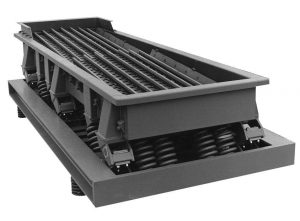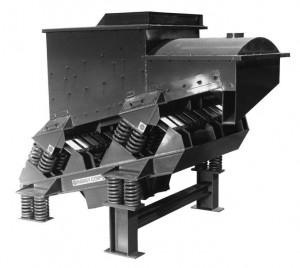Vibrating Screens
Kinergy Driven Vibrating Screens

The adaptation of the patented Kinergy Drive System to Vibrating Screens is recognized as the most significant advancement in Vibrating Screens in more than 60 years! For the first time in their long history, Vibrating Screens have the most operating versatility and Energy Efficiency.
One of the reasons for this proclamation is the full range of electrical adjustment enables all these Vibrating Screens to also perform as a Feeder. The operating versatility enables “sticky” (adhesive) bulk solids to be screened by utilizing the automatic and repetitive “pulsing” kind of vibratory action.
Another is these Vibrating Screens make use of Kinergy’s drive technology to incorporate an underside collecting pan for the “passed unders”. Thus, the steep walled collecting hopper is eliminated. That reduces the height of the building or the screening tower; thereby reducing the costs of construction and added operating expense.
Kinergy’s linear stroke Screens allow the unit to be placed horizontally or on a shallow decline; whereas, Screens with a circular or elliptical type of vibratory motion are often required to be declined 20° for the force of gravity to assist in the needed conveying.
Kinergy Vibrating Screens are the most Energy Efficient, require minimal maintenance, operate quietly and have an electrically adjustable stroke and operating frequency. All of these features combine to ensure the best performance level.
There are multiple uses for Kinergy Driven Vibratory Screens. Some include:
Cleaning “Unit Pieces”: These single-screening deck units rely on vibration to remove clinging particles, trim edges, or anything similar from “unit pieces”. Example: Cleaning the various types of briquettes, pressed logs, dried pellets, or shaking off adhered sand from metal castings.
Washing: A bulk solid or unit piece can be “washed” while it’s being conveyed by mounting rows of liquid sprays directly over the screen. The liquid spray can be water, oil, liquid detergent, a chemical solution, etc.
Sizing: Separating Flake, Floodable or General type bulk solids on the basis of their dimensional “size”.
Scalping: This technique removes “oversized” particles.
Removing “Undersize”: This is also known as de-dusting, fines removal or shaking out the “small size”.
Grading: This method is a close “particle to particle” or “particle from slivers” type of separation. As the most demanding of the “sizing” functions, multiple screening decks will be required.
Deliquefying: This process removes excess surface moisture from a very wet, lumpy “general” or a “flake” type of material.
Other uses include: Desliming, Rinsing, Dewatering, Draining, Mold Shakeouts, Recovering Mold Sand and Separating Scrap Metal from the Shakeout Sand.




Design Features of the Kingery Driven Vibrating Screen
Kinergy has the most advanced vibratory machine technology available. Our designs include the following:
• Durability: Kinergy Vibrating Screens are built to last with an average of over 20 years of productive use and an availability of 95% or more.
• Lowering Height: Kinergy’s Vibrating Screens can be installed horizontally or on a slight decline which reduces the height of the needed building or screening tower. Construction cost is reduced and the daily operating expense is less because of the lower elevation.
• Energy Efficiency: All the Screens utilize the Kinergy Drive System, which is the most versatile and energy efficient drive available. This drive is a combination of a free force input from an A.C. type electric motor with the output of sub-resonant tuned springs. When the applied load increases, the springs inherently drive harder. It maximizes the use of “Kinergy” which is defined as the kinetic energy developed by a spring’s motion during the drive portion of its cycle. Thus, a 50 to 65% power reduction can be achieved.
• Dust-Tight Construction: Kinergy Vibrating Screens are environmentally friendly. They can be made with dust-tight bodies that have a bolted top cover with quick opening “viewports” to observe the screening.
• Various Drive Configurations:
Bottom Drive Design: The Kinergy Vibratory Drive System is preferred to be located underneath the Screen body. The added bottom conveying pan for collecting the “passed unders” enables it most access to the screening decks. It is easier for dust-tight construction and it eliminates the need for the previously used steep walled collecting hopper located underneath.
Top Drive Design: The drive system is located above the Screen body. Typically the underside of the screening unit is completely open to permit the discharge of the “unders” across its width and length. If it is needed, a full length “unders” conveying trough can be supplied which makes the unit more readily adaptable to being “dust-tight”.
End Drive Design: This design can be used when head room is severely limited. The drive system can be located on either end and provides full access to the screening surfaces.
• Operating Versatility: The operating stroke and frequency is electrically adjustable. This enables the Vibrating Screens to be automatically and repetitively “Pulsed” with a more vigorous vibratory action. This helps to minimize blinding of the screen media and to minimize particle adhesion.
• Larger Dimensions: Kinergy Vibrating Screens can be manufactured in larger dimensions. Since the input dynamic forces are distributed, the diameter or length and width dimensions are not restricted as they would be if they were concentrated at one point. This is the reason Kinergy Driven Vibrating Screens that are unidirectional are standardized in widths to 18 ft. and lengths as required.
• Reduced Sound Levels: Kinergy Vibrating Screens operate smoothly and quietly, typically less than 60 dBA when in the no load or empty condition. Under load, 80 dBA should not be exceeded.
• Minimal Maintenance: Two specific design features make Kinergy Vibrating Screens a low maintenance option. First, using components specifically designed to endure the vibratory action, the maintenance requirements decrease remarkably. Second, three components make up the drive system. These components can be changed in less than one hour by two reasonably skilled technicians. No qualified journeymen are required.
• Performing as a Feeder: All Kinergy Vibrating Screens can also perform the feeding function. Install the Kinergy Vibrating Screen under the outlet of the Bin or Silo. Use the electrical control to adjust the Screening unit’s output from zero to the maximum TPH.
• Common Components: Kinergy Vibrating Screens minimize the amount of spare parts kept in stock. Most of the component parts are interchangeable with other Kinergy Driven units even though their functions may differ. These common components extend to Kinergy Vibrating Feeders, Conveyors, Fluid Bed Coolers and Dryers, Spiral Elevators and the various types of Foundry units. This reduces the number of spare parts required in inventory.
Learn more about which bulk solid materials can be applied to Kinergy Vibratory Machines.
Kinergy engineers have been industry leaders in the field of Vibratory Screens for over thirty years. To learn more about Kinergy’s Vibrating Screens, please call today at 502.366.5685 or download Kinergy’s descriptive Bulletin KDVS-1 entitled “Kinergy Driven Vibrating Screens“.












